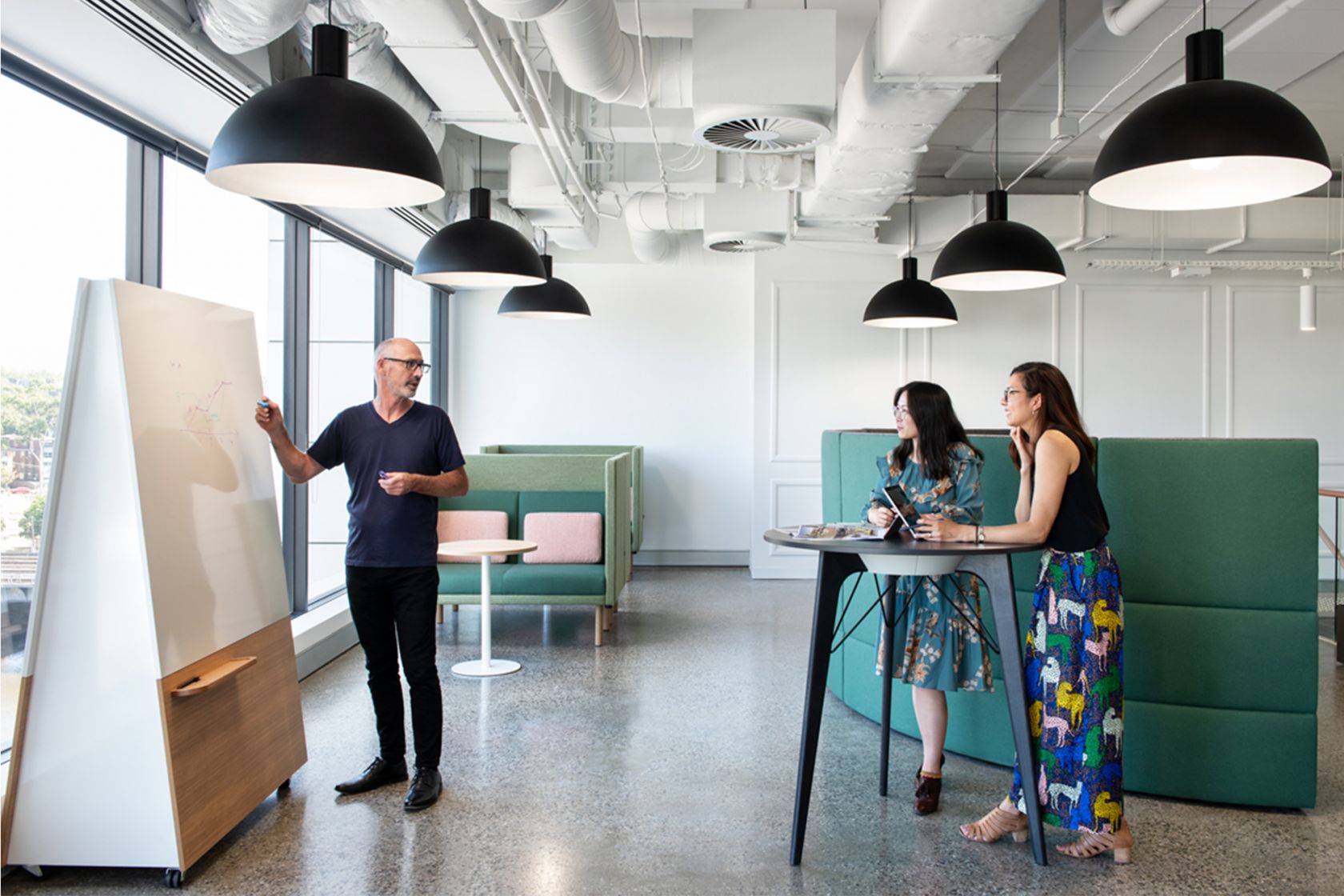
Untethering employees
To effectively support flexible working and sharing strategies, organisations must ensure that their employees are not tethered to a single work point. Tethered employees are limited, obliged to remain at one work point or location within the workspace, and do not have the freedom of choice to move and use alternative work settings.
Workspace observation studies have found that tethered employees are restricted to completing all of their tasks at the primary work point – their desk. In the workspaces observed, employees are carrying out independent work, making telephone calls, and engaging in face-to-face interactions all while remaining at their desk.
Employees are performing every function at the primary work point as they do not have autonomy, choice, or control over where they work. Restricting employees in this way is risky and can have negative consequences for organisations, including a lack of employee engagement, loss of productivity, and increased employee turnover.
Organisations are challenging the traditional workspace layout by reimagining how people are working. Within these organisations, the workspace is seen as an asset and strategic tool capable of improving business performance. A genuinely effective, flexible working environment boasts the right technological capabilities and a culture that truly endorses flexibility and trust - enabling people to work anywhere.
Fundamentally, employees are not tethered to one work point (either by technology, physical storage, or cultural expectations), but instead feel untethered and able to move around the workspace as desired. Untethering employees enables a flexible workspace to be used as intended.
Thus, organisations should create a workspace experience that provides seamless, pain-free flexibility and movement within the work environment.

Technology’s role
Effective technology integration is critical to supporting flexible working. The right technology can provide seamless movement and connectivity both throughout an entire workspace and outside of the office environment. Inappropriate or ineffective technology can result in excessive downtime, frustrated employees, and a loss of productivity.
Post-occupancy evaluations conducted in organisations that have transitioned to a flexible way of working have found that complaints and negative feedback about inadequate technology are the most prevalent and have the most significant impact on the user experience.
The first step in ensuring that organisations implement the most effective technology in the workspace is to determine how they want the space to be used by their employees. Developing personas of the different user experiences within the workspace can assist organisations in identifying their specific technology requirements to support employee behaviours effectively.
In a flexible working environment mobility is crucial, so organisations must integrate technology solutions that untether employees and enhance mobility. If employees are tethered to the desk due to physical storage or a CPU, they lose the opportunity to move and take advantage of the diverse spaces that are typically found in a flexible working environment.
In contrast, mobile devices untether employees and support movement. Introducing mobile devices means that employees are free from their desks and are given a level of control over where and how they work within the workspace.
Technology can also play a vital role in reducing the physical storage that is tethering employees to specific work points within the work environment. Through the implementation of a paper light strategy organisations can reduce their need for physical storage in the workspace; introduce a clean desk policy to promote movement and improve the security of information by utilising an online storage solution. Replacing physical storage units with an online solution will untether employees and allow them to work from any location.
In conjunction with mobile devices and online storage, ensuring that there is consistent technology – both hardware and software – throughout the workspace is also crucial. Greater consistency of technology solutions can lead to employees spending less time to learn about different equipment or programs.
This will help to eliminate any barriers or frustrations that employees encounter due to unreliable or unfamiliar technology solutions across the different work points. The right technology will support and enhance movement, allowing for a more open, active, and collaborative work environment.

Culture and leadership
When organisations implement flexible working strategies, leaders must act as role models and advocates for the change. Thus, all leaders must be on board and feel positive about flexible working.
Organisations must engage them in the change process and provide leadership training to educate them on how they are expected to lead once flexible working is introduced. Only when leadership buy-in is achieved can organisations build a culture that truly endorses flexibility, untethers employees, and fosters movement.
In successful flexible working environments, leaders understand how to work and lead flexibly. These leaders are output- and outcome-focused, support autonomy by demonstrating trust, and empower their employees to manage their own time and workload. It is this type of leadership that enhances flexibility and gives employees a choice and control over how and where they work.
Employees should have the freedom to move around the workspace and not feel like they need to be within proximity to their manager to be perceived to be working. By creating a culture of trust that supports autonomy, choice, and empowerment, leaders can ensure that employees feel untethered and free to utilize the diverse spaces and work settings that a flexible workspace has to offer.
It is the combination of the right workspace, technology, culture, and leadership that will untether people and allow them to work flexibly.
This article originally appeared on HR & Digital Trends.
